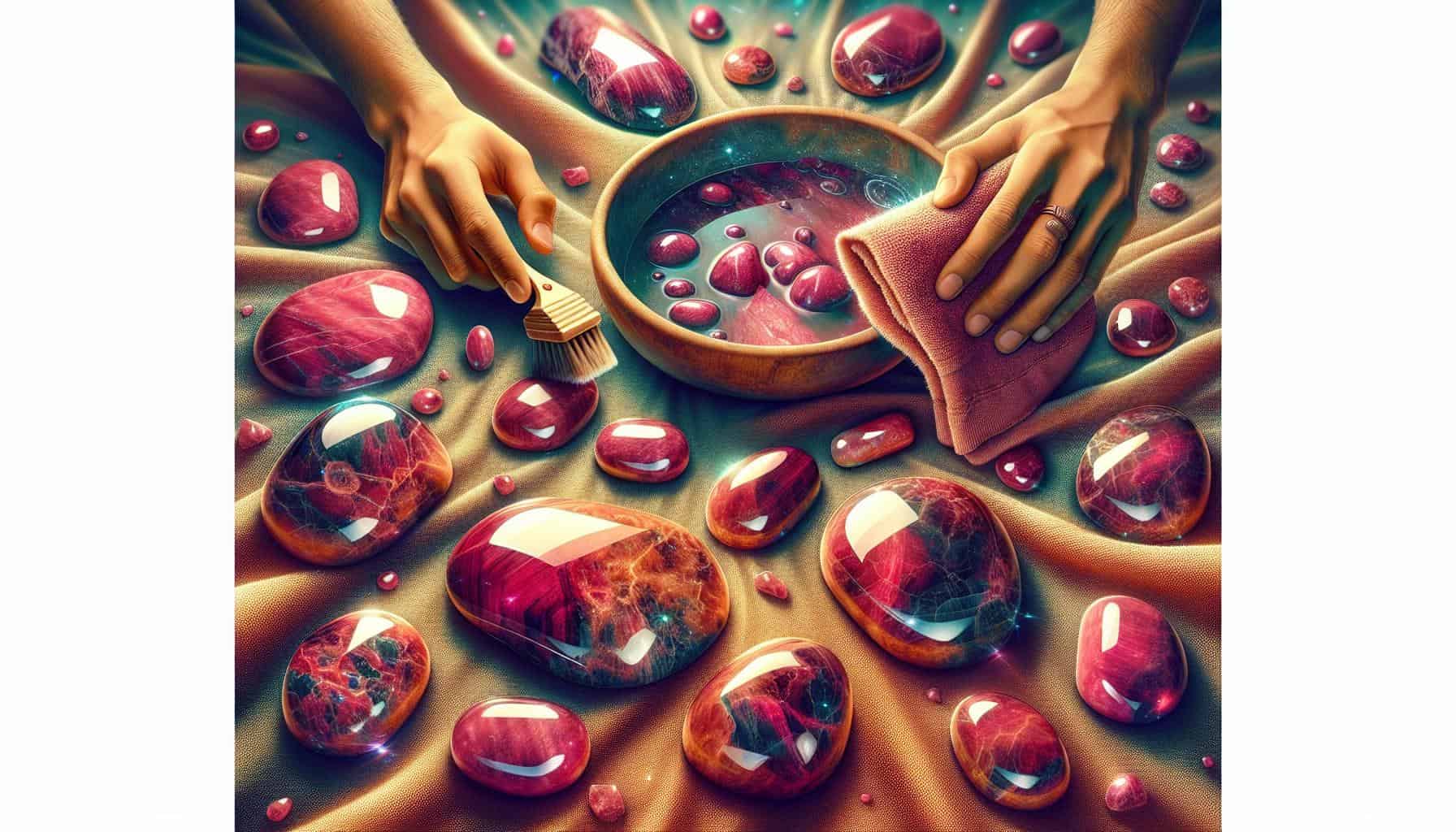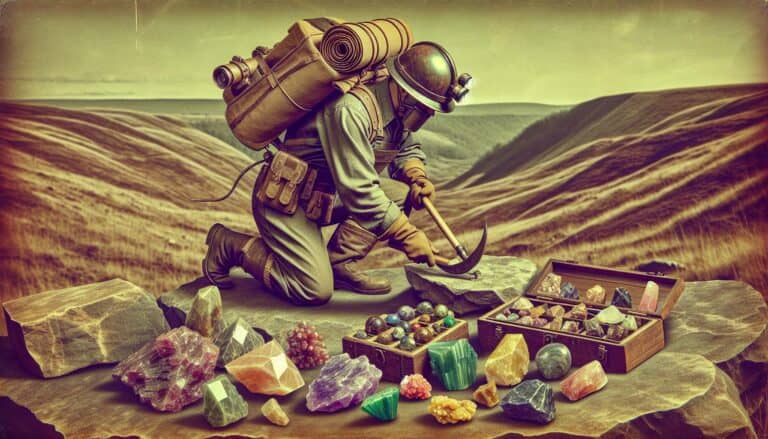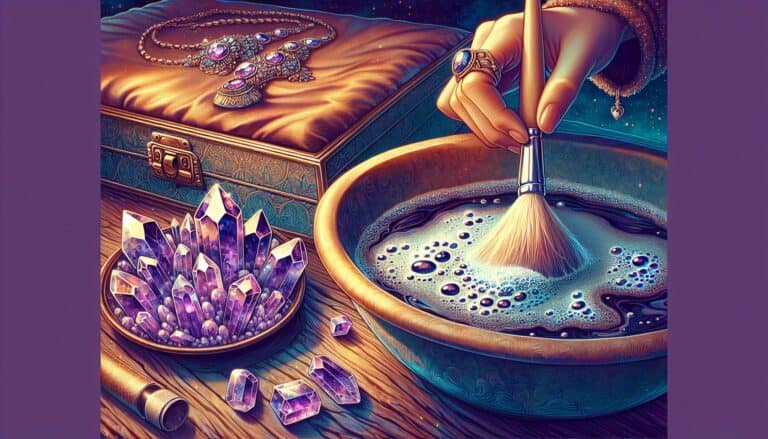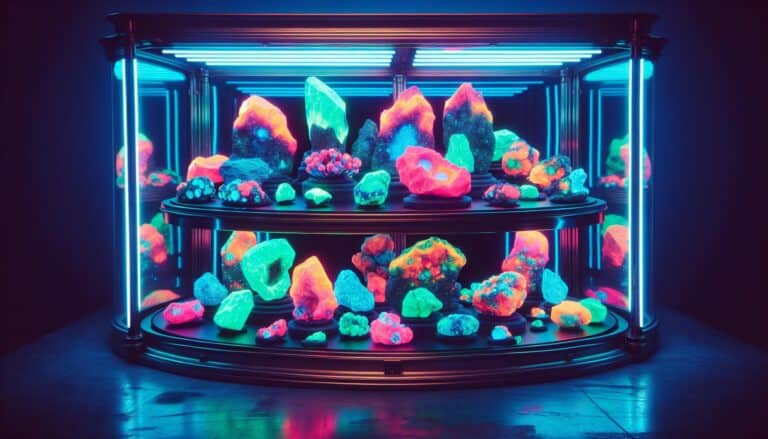Discovering the beauty of rhodonite begins with knowing how to identify this unique gemstone.
You’re about to learn the key characteristics that set rhodonite apart from other minerals. With its rich colors and patterns, it’s a favorite among gemstone enthusiasts and jewelers alike.
You’ll find that rhodonite’s distinctive features, such as its deep reds and contrasting black manganese oxide veins, make it both captivating and relatively easy to identify.
Whether you’re a budding geologist or a curious collector, understanding these traits will enhance your appreciation for this stunning stone.
To identify rhodonite, inspect for deep red to pink colors with black manganese oxide veins, and conduct a streak test for a white streak. Rhodonite is non-magnetic, ranks 5.5-6.5 on the Mohs scale, and exhibits weak birefringence, aiding in differentiation from imitations.
How to Identify Rhodonite Through Testing
Visual Inspection
Start your rhodonite identification with a thorough visual inspection. Look for deep red to pink colors and check for characteristic black manganese oxide veins that often accompany genuine rhodonite. Notice the gem’s transparency as high-quality rhodonite should display a glassy luster.
The Streak Test
Scratch your specimen across an unglazed ceramic tile, known as a streak plate, to observe the streak color. For rhodonite, you’ll typically see a white or faint pink streak, which differs from the often darker appearance of the gemstone itself.
Magnet Test
Although not definitive, the magnet test can be helpful. Rhodonite may contain significant amounts of iron, which can react to a strong magnet. If there’s a reaction, it doesn’t confirm rhodonite, but it could signify the presence of iron-bearing minerals.
Hardness Test
Rhodonite falls between 5.5 and 6.5 on the Mohs hardness scale. Use simple tools like a steel knife (5.5) and a glass plate (5.5) to scratch the stone. If your specimen leaves a scratch on the knife but not on the glass, it’s likely within the rhodonite hardness range.
Birefringence Test
This test involves looking at a crystal through a pair of polarizing filters. Rhodonite displays weak birefringence, so you’ll see little to no double images or ‘ghosting’ when you rotate the filters.
Checking The Diaphaneity
Assess the diaphaneity, or the stone’s transparency, by looking at how light passes through the rhodonite. It ranges from opaque to translucent and rarely reaches a transparent state.
Single or Double Refraction
Use a dichroscope to see if the stone is singly or doubly refractive. As a single refractive gemstone, all colors seen through the dichroscope should remain consistent, without splitting into two separate colors.
Refractive Index Test
Conducting a refractive index test using a refractometer will provide a specific reading. Rhodonite’s refractive index ranges from 1.73 to 1.76. This distinct value can help confirm the stone’s identity.
Finding The Specific Gravity
Measure the specific gravity (SG) of your stone to gather more clues about its identity. Rhodonite has an SG typically between 3.4 to 3.7, which is higher than many common rock-forming minerals.
Identifying Rhodonites in the Field
When identifying rhodonite in the field, watch for its grainy to blocky crystal habit. Check the surrounding rocks as rhodonite is often found in metamorphic environments associated with other manganese minerals.
Recognizing Potential Rhodonite Rocks
Potential rhodonite rocks have a distinct appearance. They are often banded or spotted due to the intergrowth with other manganese minerals. Feel for a smooth texture that is unlike many other rocks and always consider the context of where you find the stone, such as in stream beds or old mines.
Physical Characteristics of Rhodonite

Rhodonite’s distinctive features set it apart from other minerals. Its rosy pink to red color is typically mottled with black manganese oxide patterns, which can be a key indicator although the hue can vary due to impurities. Beyond the alluring colors, rhodonite has a prismatic crystal system that often forms tabular or prismatic crystals.
When you’re out in the field, pay attention to the texture of the rocks you find. Rhodonite has a vitreous to pearly luster, which gives it a reflective shine akin to glass or pearls. It’s this particular sheen that may catch your eye when sunlight hits the stone.
The physical durability of rhodonite can be assessed through its hardness. It falls between 5.5 to 6.5 on the Mohs scale, meaning it can scratch glass but can also be scratched by a piece of hardened steel. This factor is particularly helpful when distinguishing rhodonite from similar minerals which may be softer or harder.
Rhodonite crystals also commonly exhibit perfect cleavage in one direction. This means that if you have a sample and attempt to break it, the rhodonite would likely split along a flat plane, reflecting its crystalline structure.
Remember to scrutinize the stone’s edges for cleavage which can often be observed even in rough samples. Carefully studying these physical characteristics will advance your ability to recognize rhodonite in various environments.
How Are Rhodonite Formed?
Understanding how rhodonite is formed can further aid in its identification. Rhodonite’s origins trace back to metamorphic and manganese-rich ore deposits. These environments facilitate the necessary conditions for rhodonite to crystallize over vast periods of time.
Metamorphic Rocks:
- Transformation from existing rocks
- Influence of high pressure and temperature
- Interaction with hydrothermal fluids
The formation process starts when silica-rich fluids interact with manganese deposits during the metamorphism of sedimentary rocks. This transformative phase introduces essential elements like manganese, causing the typical pink to red pigmentation that’s characteristic of rhodonite.
Hydrothermal Circulation often plays a pivotal role in the development of the distinctive black manganese oxide veins found within the stone. It’s these patterns, along with the pink hues, that are hallmark signs of rhodonite. They occur when hot, mineral-rich fluids percolate through fractures in the rock and precipitate manganese oxides as they cool.
Geologists identify key indicators of rhodonite-rich regions by studying the geology of areas known for their historical mining activities. Your ability to recognize these environmental clues can be crucial when searching for rhodonite in the field. Keep an eye out for these contexts:
- Manganese ore zones
- Associated minerals like calcite and pyroxmangite
- Geological settings with a history of mining
Areas renowned for rhodonite deposits include Massachusetts in the USA, the Ural Mountains in Russia, and Broken Hill in Australia. Looking for rhodonite in these types of settings increases your chances of finding quality specimens.
Preparation for Rhodonite Hunting
Before you set out on your quest to find rhodonite, it’s crucial to equip yourself with the right tools. This preparation is key to ensuring your hunt is both successful and enjoyable.
Gathering the Right Tools
To maximize your chances of finding rhodonite, there are specific tools you’ll need in your arsenal:
- Geologist’s hammer: To extract samples effectively.
- Hand lens or magnifier: For closer inspection of rocks and minerals.
- Strong gloves: For protection and grip.
- Durable backpack: To carry tools and your collected samples.
- Sample bags and markers: For organizing and labeling your finds.
Selecting quality tools that can withstand rugged fieldwork is essential. This not only makes your hunt more efficient but also ensures the longevity of your gear.
Safety Considerations
Your safety during rhodonite hunting should never be an afterthought. Adhering to safety guidelines minimizes risk and guarantees that your focus remains on the thrill of discovery:
- Wear safety goggles to protect your eyes from flying rock fragments.
- Don sturdy boots with ankle support to navigate uneven terrain.
- Check weather conditions before heading out to avoid getting caught in dangerous situations.
- Inform someone about your planned location and expected return time.
- Carry a first-aid kit for immediate response to minor injuries.
Remember, being prepared and cautious is paramount. With the right approach, you’re not just setting out to find beautiful rhodonite specimens; you’re also ensuring a safe and rewarding rockhounding adventure.
Handling and Care of Found Rhodonite

Cleaning Rhodonites
After a successful day of rhodonite hunting, proper cleaning is crucial to reveal the true beauty of your finds. Start by gently rinsing the stones in lukewarm water to remove any loose dirt. If you’re faced with stubborn grime, use a soft brush like an old toothbrush for a more thorough clean. Avoid harsh chemicals; they can damage the stone’s surface. Some collectors use mild soap but ensure it’s fully rinsed off to prevent residue build-up.
For more persistent material, a soak in warm, soapy water for several hours may be necessary. Occasionally, ultrasonic cleaners are employed, but use them with caution as they can sometimes cause fracturing in the stone. After the cleaning process, pat the rhodonites dry with a soft cloth, and allow them to air dry completely before storage.
Storing Rhodonites
Once you’ve cleaned your rhodonite specimens, you’ll want to ensure they are stored properly to prevent damage. Wrap each piece in soft cloth or place it in a fabric-lined box to avoid scratches. Rhodonite, with a Mohs hardness of about 5.5 to 6.5, can be susceptible to scratches if stored carelessly. Keep them away from harder minerals to maintain their luster.
If you plan on displaying your rhodonites, consider a case that protects them from dust and reduces the risk of accidental chips or scratches. Also, direct sunlight can cause some minerals to fade, so your rhodonite specimens should be kept out of prolonged exposure to sunlight.
Monitoring environmental factors is also essential. High humidity can lead to moisture damage and potential tarnishing, so store your rhodonites in a controlled environment. Desiccants such as silica gel packs in storage areas can help keep moisture at bay, ensuring your rhodonite specimens remain pristine.
By following these steps, you can keep your rhodonites clean and well-preserved, showcasing their natural beauty for years to come.
Conclusion: Confirming Rhodonite is Real
Identifying rhodonite is a rewarding experience that combines visual inspection with careful handling.
Remember, keeping your rhodonite clean and well-preserved enhances its beauty and value. By rinsing with lukewarm water, using a gentle brush, and avoiding harsh chemicals, you’ll maintain its luster. Proper drying and storage are just as crucial; wrap your find in a soft cloth and keep it away from harder minerals to prevent scratches. Protecting your rhodonite from direct sunlight and controlling humidity with desiccants will ensure its longevity.
With these simple yet effective steps, you’ll not only confirm your rhodonite find but also cherish it in pristine condition for years to come.







